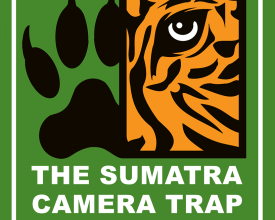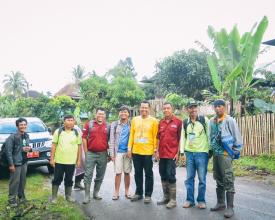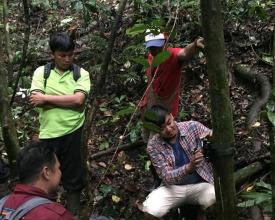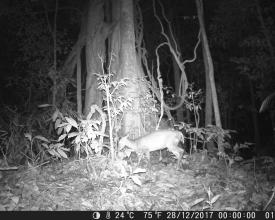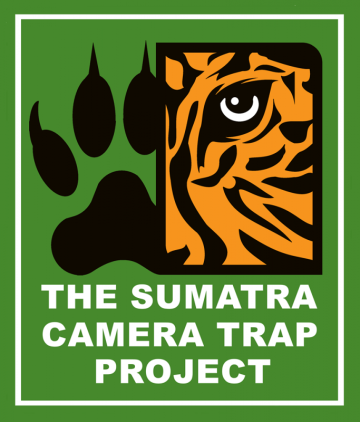
The Sumatra Camera Trap Project
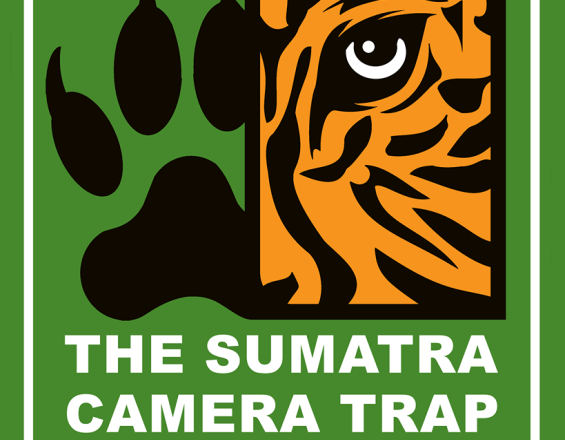
The Sumatra Camera Trap Project is a pilot camera trapping project initially within Isau Isau Nature Reserve, South Sumatra. The project is running with the express permission of the Nature and Biodiversity Agency of South Sumatra. The hope we have is that the project will highlight the inhabitants of the nature reserve and raise the profile of Isau Isau Nature Reserve both locally and globally. We have been given six fauna target species, the Sumatran tiger ( Panthera tigris Sumatrae), Malayan tapir ( Tapirus indicus), Sun bear ( Helarctos malayanus), Sumatran serow ( Capricornis sumatraensis), Sunda Clouded Leopard ( Neofelis diardii) and Northern Dhole (Cuon alpinus).
As well as already capturing the first images of sun bears in over a decade, we have also identified new populations of animals that have never been recorded inside Isau Isau Nature Reserve, such as Mitered Leaf Monkey (Presbytis melalaphos) and Binturong (Arctictis binturong).
Context
Challenges addressed
Since there is no current record for what resides with Isau Isau Nature Reserve, we are relying on evidence from over thirty years ago and also the anecdotal evidence of the local populus.
Currently, our project is entirely privately funded. This means that we must be mindful of resource use, as well as the speed in which we can expand.
During some of our deployments, we have found evidence of human activity in an area that is restricted. We have to approach this subject in a sensitive manner with the local people as we would much rather maintain our good relationship with the local people, as they are proving to be a valuable asset, in terms of providing fruitful locations and aid during the deployment.
We have had to almost abandon one of our study sites due to recent human activity which has impeded our ability to inventory species with these areas and to monitor animal numbers.
Location
Process
Summary of the process
Raising awareness globally is important to us for a number of reasons, so we are very active with our online presence. We are also looking for collaborations or "shout outs" from established organisations to increase our exposure.
We are also trying to raise aware of what is residing inside Isau Isau Nature Reserve with the locals. This had lead to increase interest from the local population, especially with the field team. More people are requesting to go on the treks into the jungle to deploy the camera traps. It is vital to keep the local villagers happy for the success of the project so occasionally villagers will go on the treks to see the undetaking and the field team will show them how the cameras work. Being successful in our project is understanding how everything is intertwined and then it is about creating a balancing act in what can sometimes be quite a delicate situation.
Building Blocks
Raising awareness through social media
We are heavily using social media to share the findings of our project. Overall the response has been very good. Due to work and family commitments, we have had to take on a social media co-ordinator to further our cause. Currently, I am funding this project by myself but we are hoping that our online presence might later lead to some outside funding.
Enabling factors
Due to the following we have, we need to be very sure of what we are putting into the public eye. I want our project to be as transparent as possible to our followers so we have to be mindful that we have a vast array of followers from career conservationists to everyday people who are passionate about saving nature.
Lesson learned
-Finding a balance to suit the audience was very important and it was a learning curve to adjust to that.
-Dealing with negativity (which has only happened on one occasion). It is difficult when somebody is negative about something you are passionate about but a cool head and a professional approach lead to a de-escalation of the comments.
-As a result of our passion and transparency, we have a global following and a far reach.
Training on the use of camera traps
Camera traps are a new piece of technology for the field team. Training is a mixture of remote conversation and trial and error. I have used camera traps before but I am not able to get to the field to conduct training with the cameras.
Enabling factors
An understanding is required on both sides. With a mixture of feedback from the captures and trial and error, we have improved our chances for collecting useable images.
During the first deployment, the camera was placed too high and the quality was low, leading to few pictures with identifiable subjects but we were able to discuss how to improve our chances based on the results we had.
Lesson learned
-Patience is the key. It was a bit frustrating that I couldn't be in the field to conduct training on how to use the camera traps but we had to make the best of what we had.
-We reviewed the results together and discussed how we could improve our chances until we found a method that worked well.
Raising awareness with the local population
We are currently collaborating with a youth educational initiative known as The Jungle Library Project. Their team goes to schools in close proximity to our study areas and teaches the students about the importance of the ecosystems they live in, aided by the use our images.
Our images are also shared with the local villagers upon return from deployment. This increases the trust and support we have with these local people who are just as keen to protect Isau Isau as we are.
Enabling factors
A strong and transparent relationship with both the local villagers and other projects operating in our study area.
Lesson learned
-Transparency is the key to gaining the trust of curious locals. On our first deployment, we had 11 people join the field team. The deployment was not a huge success with the number of people possibly being a contributing factor but we believe that inviting them from the very beginning to see the process and be open with what we are doing has helped create a very good working relationship.
Impacts
So far the project has taken the first pictures of Malayan sun bears with Isau Isau Nature Reserve. We currently believe that this population has never been recorded so it is of huge importance. Once our initial study is complete, we may undertake a targeted study of the sun bear population within Isau Isau. We have also captured evidence of some protected species such as Sambar deer (Rusa unicolor equina) and a possible Asiatic golden cat (Neofelis temminckii).
As well as our animal images, we have also captured evidence of an illegal group of poachers. One of our collaborators was able to successfully identify these individuals which lead to a mediation with the group. This culminated in the signing of an agreement that if these men are found to be entering the forest for illegal activity that the police will then become involved and the images will be shown as evidence.
Beneficiaries
The Nature and Biodiversity Agency of South Sumatra
Story
In late 2017, I had to give up the job as a zoo keeper at a conservation charity in Kent, England. It was position that I had been working towards for my whole life. After my partner was made redundant upon returning to work from maternity leave, we could not live on the wage of a zoo keeper so we made the difficult decision for her to return to work and for me to stay at home with my son. It was the right decision but it was devestating at the same time and drove me into a depression. This is when I met my colleague and friend Pungky Nanda Pratama. Pungky is a hugely inspirational conservationist working in South Sumatra. He contacted me due to our similar interests. I had partaken in camera trapping projects as part of my previous work place so I was surprised to hear that there were no camera trapping projects happening in and around the area where Pungky lives. I really wanted to still be contributing to conservation so we quickly agreed that we thought we would work well together. I took a part time job when I had child care covered to earn some money to buy a camera trap. The first camera arrived in mid-March and was deployed and since then we have grown the project with captures of species such as wild pig, sambar, asiatic golden cat and also what we believe to be an unrecorded population of sun bears. We have also captured images of a group of poachers. After a successful identification from one of our collaborators, we were able to initiate a successful mitigation with the poaching group.
